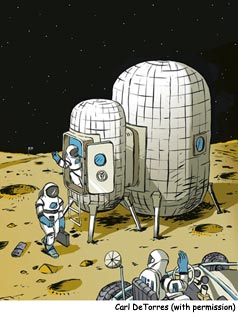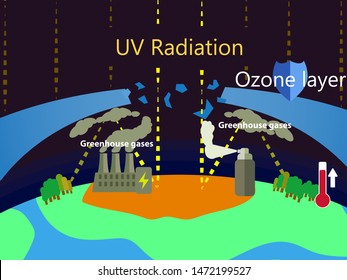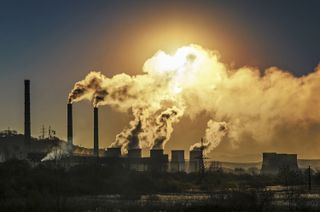Chapter 5
Could we live on Mars?
Climate change and population
Contents of chapter
1.1 The oceans are rising.
1.2 Protection from the Sun's rays is being lost
1.3 The population on Earth is also rising
The first topic of this website is:
"People living on Earth may one day need to live on another planet." No. 3 here
The first few may live and work like this. 

There's a lot to look at.
1 Climate change
Within the topic of climate change:
1.1 The oceans are rising.
1.2 Protection from the Sun's rays is being lost
1.3 The population on Earth is also rising
1.2 Protection from the Sun's rays is being lost
1.3 The population on Earth is also rising
An astronaut is shown against a background of space-dust.*
The picture and the text on the left are from the Home page here.

* Space-dust particles are important to processes in the universe.
- Oceans are rising around the world, causing dangerous flooding.
- Average sea levels have swelled over 8 inches (about 23 cm) since 1880, with about three of those inches gained in the last 25 years.
- Every year, the sea rises another 0.13 inches (3.2 mm).
- The expected rise in sea levels due to climate change will result in coastlines receding worldwide through erosion.
- The two major causes of world sea level rise are heat expansion caused by warming of the ocean, (water expands as it warms), iceberg melt, and increased melting of land-based ice, such as glaciers and ice sheets.
- The oceans are absorbing more than 90 percent of the increased atmosphere heat associated with gases produced by human activity.
- That's not the only problem for the oceans. They are being filled with plastic, it also causing the death of sea creatures.
- There are currently 5 trillion pieces of plastic waste in the world's oceans, according to The Ocean Cleanup, a project which plans to rid the ocean of waste.

1.1.16 Will we all drown?
Since at least the start of the 20th century, the average global sea level has been rising. ...
This increase is due mostly to human-caused global warming, which is driving heat-expansion of seawater and the melting of land-based ice sheets and glaciers.
1.2 Protection from the Sun's rays is being lost  *
*
 *
*- Life on Earth is dependent on radiant energy from the sun. UVR - ultraviolet radiation is the problem
- These are the classifications most often used in Earth sciences:
- UV-C rays are the most harmful and are almost completely absorbed by our atmosphere.
- UV-B rays are the harmful rays that cause sunburn.
- Exposure to UV-B rays increases the risk of cell damage in living beings.
- About 95 percent UV-B rays are absorbed by ozone in the Earth's atmosphere.
- Ozone protects life on Earth from the Sun's ultraviolet (UV) radiation.
- Ozone is a pale blue gas. It is a form of oxygen.
- The common form of oxygen is a gas that humans and animals need to breathe.
- *The Earth's atmosphere, about 15 miles (24 kilometres) above the surface, includes the ozone layer. It protects us by absorbing harmful rays from the sun. Gaps in it as shown in the picture increase amounts of UV radiation reaching us.
- Greenhouse gases cause damage to the ozone layer.
1.2.1 Greenhouse gases 

- A greenhouse gas is any gas in the atmosphere that is capable of absorbing infrared radiation, thereby trapping and holding heat in the atmosphere.
- By increasing the heat in the atmosphere, greenhouse gases are responsible for the greenhouse effect, which ultimately leads to global warming.
- The amount of gases in the atmosphere has skyrocketed in recent history.
- Scientific evidence paints a clear picture:
- Climate change is happening, it is caused in large part by human activity, and it will have many serious and potentially damaging effects in the decades ahead.
- The main cause is greenhouse gas emissions from cars, power plants and other human-made sources—rather than natural variations in climate.
.12

1974 4 billion
1987 5 billion
1999 6 billion
2012 7 billion
2027* 8 billion
2046* 9 billion * estimate
1.3.1.1
In 2027, the world is likely to have doubled its population in 53 years.
1.3.1.2
The world population reached a billion around 1804. It then took about 123 years to double to 2 billion (in 1927), and 47 years to hit 4 billion (1974). The world population is estimated to reach 8 billion in 2027 taking 53 years to double from the 4 billion mark
1.3.2
The figures show huge numbers in the future to be spread around less land as we saw in 1.2.
1.3.3
Increases in the number of humans affect the world temperature.
1.3.4
The science on the human contribution to modern warming is quite clear.
1.3.5
Human emissions and activities have caused around 100% of the warming observed since 1950, according to the Intergovernmental Panel on Climate Change. Through its assessments, the IPCC determines the state of knowledge on climate change.
1.3.6
It took over 200,000 years of human history for the world's population to reach 1 billion, and only 200 years more to reach 7 billion.!
pagetop here